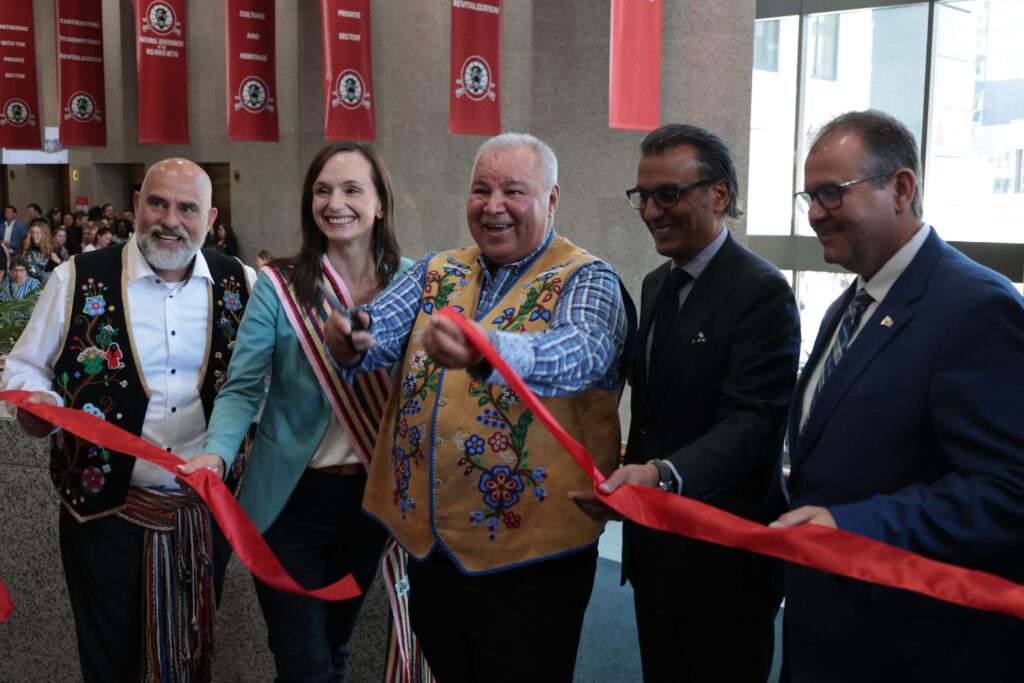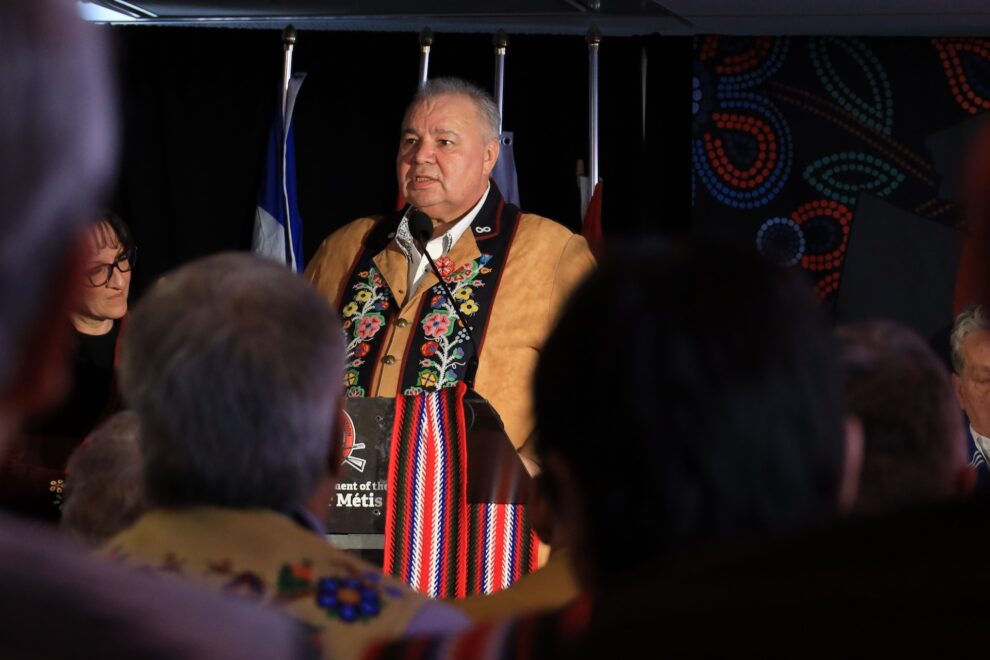For much of its 58-year history, the Manitoba Métis Federation (MMF) has flown under the radar when it comes to the economic impact it’s had in this province.
That’s changing.
The MMF’s economic profile has risen considerably over the past several years. It began with the acquisition of the former Bank of Montreal building at 355 Main St. in Winnipeg five years ago, a space that will soon be home to the Red River Métis National Heritage Centre. Since then, the federation has acquired office towers formerly owned by Bell MTS at 333 Main St. and 191 Pioneer Ave. It has also expanded its footprint in downtown Winnipeg with the recent purchase of the former Wawanesa Insurance building at 200 Main St. and an adjacent property at 165 Fort St.
The official government of the Red River Métis has also taken on the role of property developer. It has developed several seniors’ housing complexes in Winnipeg and elsewhere in Manitoba. The most recent is a six-storey, 77,900-square-foot, 55-plus complex on Eveline Street in Selkirk that is home to 49 Métis seniors and elders. Construction of two additional seniors’ apartment blocks in Winnipeg is slated to begin over the next couple of years.
An economic injection
So, how much has this injected into the Manitoba economy? A recent report conducted on behalf of the MMF estimates the federation’s core operations and programs alone generated $479.1 million in economic impact from 2018-2022, a number that has surely climbed since.
MMF president David Chartrand says all these recent projects are part of his government’s strategy to be an economic engine for change in Winnipeg’s core and elsewhere in the province.
“We’ve been fortunate enough to be successful with some of our ventures so we said, ‘OK, let’s start investing in the downtown,’” he explains.
“I’m a strategic thinker and I made sure that we were investing and stashing away our resources and building our economic strength and putting ourselves in a position where we can make decisions of this nature. We’re not looking for a handout. We’re coming in with our pockets full, ready to invest.”

The centrepiece of those efforts will be the Métis National Heritage Centre on the corner of Portage and Main. It is expected to attract more than 25,000 visitors annually when it opens to the public in 2027. More than $33 million is being spent on renovating the structure that was built in 1913.
Chartrand is excited about the centre’s potential for raising the profile of Métis people and the lands they call home.
“This is going to tell the story of who we are, but it’s also going to tell the story of our Prairies,” he says. “It’s truly going to be a place that will be seen and sought after not only by our people in our province and in Canada, but by people around the world.”
Repopulating downtown Winnipeg
Chartrand acknowledges that acquiring the two former Bell MTS towers comes with some risk. Vacancy rates in Winnipeg’s downtown remain fairly high and Bell MTS has already indicated it plans to move most of its staff out of the buildings.
However, he maintains the MMF has an important role to play in the ongoing efforts to revitalize the city’s core and needs to do more than just pay lip-service to the challenges the downtown is facing.
“I could be out there saying this should be done or that should be done. That’s the simple thing to do,” he says.
“But if you’re not investing or not planning to really jump in there and take that risk, you’re not doing anything. It’s easy to be a critic. But to be a solution-oriented pathway, that’s a whole different challenge. You need to put your money where your mouth is and actually show that you are serious.”
The MMF’s investment in downtown Winnipeg isn’t slowing down.
It is on the verge of acquiring two more properties on the fringes of the city’s core that should be announced soon. It’s also moved 600 of its employees downtown to provide a boost to restaurants and other area businesses and is looking to add to its stable of childcare centres with a new downtown location. In addition, the MMF’s cabinet recently approved a proposal to build a number of electric vehicle charging stations at several of the downtown properties it owns.
Chartrand says he hopes those efforts will help convince city hall and the provincial government to follow the MMF’s lead and have all of their employees return to their downtown offices full-time and help recreate the hustle and bustle of pre-COVID times.
Homes for all
It’s no secret that Manitoba, like most parts of the country, is experiencing a housing shortage. That’s what led the MMF to introduce its First Time Home Purchase Program (FTHP), which is now in its fifth year. The program, delivered through the Louis Riel Credit Corporation, provides qualifying Métis individuals with a five per cent down payment towards the purchase price of a home up to a maximum of $18,000 as well as up to $2,500 toward legal and land transfer fees.
To date, nearly 2,200 families have purchased a home through the program. It’s estimated the FTHP has resulted in new mortgages valued at more than $390 million and tens of millions of dollars in home improvements.
“Banks are now knocking on our door and saying, ‘can we come in and be the lender of choice?’ That didn’t happen years ago,” Chartrand adds.
The MMF decided to make seniors’ housing a priority after conducting an analysis a few years ago that showed many seniors in the Métis community were struggling to find affordable housing.
The apartment complex in Selkirk is the latest in a series of seniors’ housing projects the MMF has spearheaded. It joined several other completed projects in communities such as St. Malo, St. George, St. Eustache and Brandon. Construction of two other complexes is slated to begin soon. The first will see the former Roxy Lanes on Henderson Highway in Winnipeg demolished to make way for a 50 to 60-unit affordable housing facility for seniors. The other will see the Métis Child, Family and Community Services building at 2000 Portage Ave. razed and replaced with a new, multi-unit apartment complex.
“We saw after we did our analysis is that our seniors … have worked all their lives, paid their taxes and are now struggling to live. We said we can’t have them living in conditions where slum landlords take advantage of them or where they find themselves homeless,” Chartrand says.
“This is something that we owe to our people. They give us their full life during their working career. Now we want to make sure they leave the working world or retire from it in a state of pride.”
Stepping up to fight wildfires
The Manitoba Métis Federation (MMF) played a key role in assisting Manitobans who were displaced earlier this spring and summer during the worst wildfire season in at least 30 years.
The MMF opened a reception centre for wildfire evacuees at 406 McGregor St. in Winnipeg. The centre was closed when the situation in many northern communities improved but reopened July 10 when it once again worsened.
The federation also set up a donation centre where it accepted a variety of items including adult and children’s clothing, strollers and diapers.
It also provided temporary housing for people who had been evacuated from their home communities at two locations in Winnipeg. One was an apartment block operated by the Métis Child, Family and Community Services on Edison Ave. The other was a building on Notre Dame Ave. that normally provides temporary housing and supports to individuals who have left their home community to receive medical care in Winnipeg.
“We just said we’ve got to do our part,” Chartrand says of the MMF’s relief efforts.
“Manitoba has a big heart and the response we got from our citizens was just fantastic. I’ve got to give our staff all the kudos in the world. Our people have been working around the clock. It’s been remarkable the way they’ve turned things around.”






